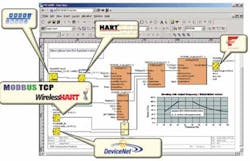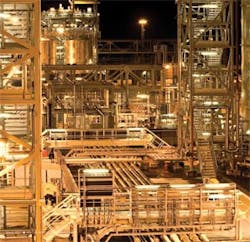Control Made Seamless
Achieving seamless integration of the many different control disciplines required to run a modern processing facility has in many ways never been easier. If one is lucky enough to start from scratch, today's most capable controller platforms are both open and scalable, and can natively address a broad range of disciplines that traditionally required separate systems, often from different suppliers. And if legacy systems are a necessary part of the application mix, those same multi-functional controllers offer an unprecedented ability to seamlessly communicate over a broad range of digital protocols.
Seamless integration at the instrument network level requires the ability to seamless accommodate multiple fieldbus protocols.
In the case of ABB, the System 800xA's flagship controller, the AC 800M, provides the ability to integrate a broad range of networks, fieldbuses, serial protocols and input/output (I/O) subsystems. It provides seamless execution of advanced and process control strategies as well as safety, electrical, quality control and power management applications. The platform's extensive portfolio of communications modules also enables seamless integration of legacy controllers from ABB and other companies, as well as "non-traditional" automation devices, such as intelligent electrical devices (IEDs) via the IEC 61850 standard.This flexible, unified field network architecture supports improved visibility and enhanced device diagnostics as well as distributed applications such as control in the field. Significant benefits can be achieved including improved process integrity, higher availability, and open and scalable information integration across the plant
Twelve Buses, One Controller
At the level of field instrumentation, a variety of standards-based fieldbus and, more recently, wireless networks provides an efficient means of gathering both process and diagnostic data from intelligent field devices. Once within the control system network, this data can be used for control and visualization as well as for condition monitoring, asset optimization or other non-control applications. From an architectural standpoint, it is important that one's control system offer the flexibility to communicate over any of the standard fieldbus and wireless protocols, allowing ultimate freedom of choice depending on a particular application's technical and business requirements.
From a practical standpoint, too, various instruments and field devices may communicate over a more limited range of standard protocols either because of their specialized nature or even country of origin. Further, there is an enormous opportunity today to integrate intelligent devices that have not traditionally been part of the process automation mix.
Setting the capabilities curve on this particular measure is ABB's System 800xA AC 800M controller, which can mix and match incoming information from any combination of up to 12 direct fieldbus connections. These module options include those for serial communications, Modbus TCP, Profibus DP, Profinet, Foundation Fieldbus, EtherNet/IP and IEC 61850 as well as ABB's own Masterbus 300, S100 I/O, Trio I/O, Satt I/O, INSUM and DriveBus protocols. Intrinsically safe I/O, SIL-rated I/O, and modular packaging options allow maximum flexibility in terms of I/O deployment.
Supporting this broad range of fieldbus options delivers significant value to the end users in the form of both capital expenditure savings (wiring, footprint and weight) and operational expenditure savings (heating and cooling, design flexibility and implementation of asset management and maintenance strategies). These protocols enable integration of data and devices from almost any compliant source. Further, the controller architecture is designed to allow individual controllers to see information from nearly anywhere on the entire network; there's no need for the individual controller-dedicated I/O structures of the past.
At the Shell Ormen Lange site in Norway, the largest System 800xA Asset Optimization application in the world is monitoring some 3,000 HART and fieldbus-based instruments and valves positioners (from ABB and third-party suppliers) as well as as a range of IT assets, including 30 servers, 20 clients, and 200 switches. For critical rotating assets, for example, a compressor curve application compares expected performance against actual process measurements.
System 800xA also leverages the WirelessHART communication standard to wirelessly capture process variables and diagnostic data. WirelessHART data can be used within any System 800xA control or monitoring application, and for advanced asset optimization and maintenance strategies. System 800xA's WirelessHART integration, combined with ABB Instrumentation WirelessHART adapters and wireless consulting services offerings, delivers the complete package necessary to help users implement solutions tailored to their needs.ABB's longer term vision of field networking acknowledges the convergence of field networks on the same Ethernet standards, including Foundation HSE, Profinet and IEC 61850. Since all of these protocols utilize the same Ethernet physical layer—whether copper, fiber or wireless–these different protocols can exist simultaneously on the same physical network infrastructure.
Leverage OPC for Controller Integration
One step up from the field, at the application level, consider an architecture that leverages the full suite of OPC standards—from OPC DA (Data Acquisition) to AE (Alarms & Events) to HDA (History Data Access)—to provide a consistent means of integrating third-party process controllers, including programmable logic controllers (PLCs) and other devices. New developments in OPC UA (Unifed Architecture) also are perfectly suited due to the object oriented, hierarchical structure of System 800xA
The OPC connectivity that is part of System 800xA's integration platform enables connection of third -party DCS controllers and PLCs. And, once connected, the data becomes part of the system in the same way as other integrated ABB hardware and software components.
The operator can then view and interact with all of the equipment that he is responsible for without having to look at multiple screens or log into multiple systems. This makes the operator much more efficient and provides him a complete view of the unit or plant. Further, it provides a migration path for older systems, enabling a longer useful life, and reduces training requirements.
At the applications level, System 800xA includes a common engineering information and visualization environment—an information "bus" of sorts—that facilitates seamless integration of third-party applications such as for integrated document management, electronic logbooks and laboratory systems that traditionally have not been integrated into the process automation architecture. With these and other integrated solutions, common visualization across plant areas delivers savings in engineering as well facilitating the right operational and business decisions and actions to maximize productivity.
One key aspect of the seamless integration of process and diagnostic data in the System 800xA environment is the ability to facilitate comprehensive device management and asset optimization strategies. ABB offers native solutions supporting a broad range of asset management tools and strategies, including condition-based monitoring, predictive maintenance. instrumentation health, process optimization, energy management and other "green" initiatives, alarm management, health/safety/environmental and other compliance issues, asset management benchmarking services, remote diagnostic services, and IT equipment and infrastructure health.
System 800xA Asset Optimization (AO) is unique in the marketplace in that it brings together, in one user interface, a composite view of the health and performance of each plant asset. Transparently maintaining all the richness of information, advantages and capabilities of each specialized system, AO eliminates the need for the user to switch between several systems, workplaces, application environments and navigation schemes.
Ethernet Communications Options for the System 800xA
IEC 61850 – System 800xA's IEC 61850 communications module is a key addition to AC 800M communications that enables users to finally optimize the use of their electrical subsystems within a facility relative to the power utilization required by the process manufacturing needs in real-time.
Foundation HSE - System 800xA's support for Foundation Fieldbus (FF) includes both HSE and H1 networks. Foundation Fieldbus offers the unique capability to fully distribute control into the field devices with the use of function blocks similar to those used in most distributed control systems (DCSs) today. System 800xA is the only DCS that offers a full implementation of FF HSE and FF H1, providing significant benefits to the user unmatched by an "H1 only" solution.
Profibus/Profinet - Profibus DP and PA are used for many applications, including remote I/O with ABB's S800 and S900 products, connectivity to devices like transmitters and valves, and solutions with AC and DC drives. Available in the latest System 800xA release, Profinet now provides many of the features of Profibus DP on an Ethernet backbone using the same tools and seamless connectivity features users of Profibus networks already know.
EtherNetIP/DeviceNet - Also included in the latest release of System 800xA are EtherNet/IP and DeviceNet communications modules. EtherNet/IP is the TCP/IP Ethernet extension of DeviceNet (and ControlNet). In addition to the speed increases achievable with Ethernet, the protocol includes standard object and device models to simplify communication message structures. A primary application of EtherNet/IP within System 800xA is to provide high speed connections to programmable logic controllers (PLCs) and Motor Control Centers (MCCs) that use this protocol.



